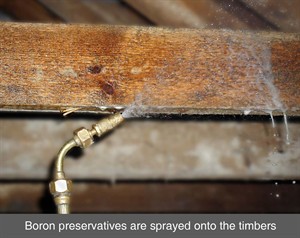Boron Timber Preservation
 Boron Timber Preservatives are
generally painted or sprayed on where the timbers within a building
have been subject to decay: dry rot, wet rot, or woodworm
infestation.
Boron Timber Preservatives are
generally painted or sprayed on where the timbers within a building
have been subject to decay: dry rot, wet rot, or woodworm
infestation.
Boron is a naturally occurring inorganic element which is very
effective at preventing and eradicating fungal and insect attack in
timber. It is water based, has very low toxicity (actually
being required in the human diet at low levels), and low
environmental impact.
Traditional timber preservatives penetrate just below the
surface (approximately 5mm), whereas Boron, in effect, migrates to
the areas at greatest risk of wood decay. As it is mobile,
Boron follows the moisture gradient, where the risk of decay is at
its greatest.
Dry Rot
Dry rot seriously affects the strength of timber: it is
therefore imperative that, firstly, the affected timbers are
removed and replaced (if necessary, using a Timber
Resin Splice method), and that the source of the damp (rising or penetrating)
has been eradicated. Any remaining timbers in high risk areas
(eg joists bedded in the masonry), if they are to be retained,
should be treated with a boron preservative. Dry rot fungus
can travel along other non-timber material, such as masonry &
plaster; therefore, the areas surrounding the infected area also
need to be investigated.
Wet Rot
As wet rot is less invasive than dry rot, removal of the source
of damp and the affected timbers may suffice. High risk areas
of timber should however be treated with a boron preservative.
Woodworm Infestation
Where woodworm infestation is particularly severe, Boron
preservatives may used, due to the preservatives ability to
penetrate deep through the timber. However, it would be more
common for us to use an insecticide treatment
when dealing with a woodworm infestation.
We provide an insurance backed guarantee for all remedial
timber works carried out.